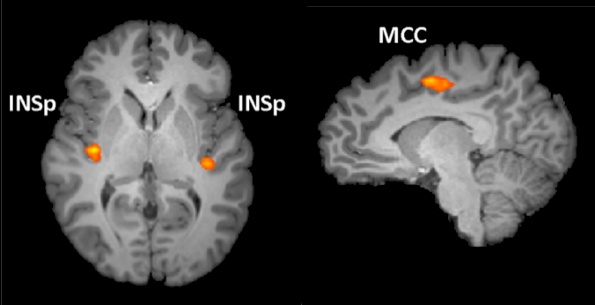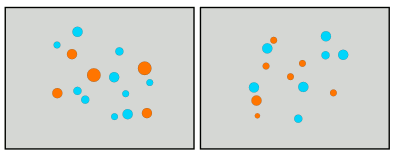Math Anxiety
November 14, 2012
Math and
physics have one thing in common. They're not just one thing, but many things rolled into a topical name. Although the interrelatedness of all things physical is stressed in its teaching,
pulleys do seem to
students to be quantitatively different than
quanta.
It's no wonder that students are confused. Once you know that
2 + 2 = 4, they hit you with
2 x 2 = 4. Then there's
trigonometry and
algebra; and, for most students, some
calculus. It's enough to give a student fits.[1]
Ian M. Lyons and
Sian L. Beilock of the
Department of Psychology, the
University of Chicago have just published a paper on
PLoS ONE that reports on a study of math
anxiety.[2] Their research, funded by the
National Science Foundation, showed that when an important math task, such as an
examination, is imminent, people with higher math anxiety will actually feel pain.[2]
Subjects were selected for the study through
interviews scored according to what's called the
Short Math Anxiety Rating-Scale (SMARS). The high math anxiety subjects, and a
control group of non-anxious individuals, completed a word task and a math task while being monitored using
functional magnetic resonance imaging (fMRI), a technique in which
blood flow is measured as a means of detecting
brain activity.[2]

This is your brain on math if you have high math anxiety. These fMRI images highlight The dorso-posterior insula (INSp) and mmid-cingulate cortex, regions of the brain affected by math anxiety. Figure 1 of ref. 2 (reformatted), licensed under the Creative Commons Attribution License.[2)]
The fMRI imaging showed increased activity in the
dorso-posterior insula (INSp) and
mid-cingulate cortex (MCC). These areas are also associated with pain perception. The INSp math anxiety regions that were active are
anatomically close to the regions that are activated when a person experiences severe
social rejection.
All this happens in anticipation of doing math. Quite surprisingly, this response was not seen during math performance; that is, the math, itself, doesn't hurt; rather, it's the anticipation of doing math that's painful. Since
humans try to avoid pain, the result is that people with high math anxiety will avoid math. They avoid
careers that require mathematics study.
Since we're on the topic of the
psychology of mathematics, there's another recent paper that relates the ability to
estimate, without
counting, the number of objects in a group with
higher mathematics skills.[3-4]
Psychologists at
Emory University (
Atlanta, Georgia) tested the ability of 65
undergraduate college students to estimate which of two images had a greater number of objects, or a greater cumulative
area.
In the number estimation test, the students were shown images of dots, in two different colors, flashed for just 200
milliseconds on a
display screen (see figure). They were asked to choose which color had the greater number of dots. It's easy to distinguish ten dots from five, but some people have the ability to distinguish nine from ten dots.[4]

Number estimation images, adapted from ref. 4.
(Image rendered by the author using Inkscape)
The students were also given a series of mathematical aptitude tests, and it was found that the ability to do number estimation
correlated with ability to do
arithmetic; and the ability at area estimation correlated with ability to do
geometry. These correlations were true even when
general intelligence was considered.[3]
Stella Lourenco, lead author and a psychologist at Emory University, remarked that
"Our results clearly show that uniquely human branches of mathematics interface with an evolutionarily primitive general magnitude system... We were able to show how variations in both advanced arithmetic and geometry skills specifically correlated with variations in our intuitive sense of magnitude."[4]
References:
- How can I resist mentioning that Isaac Newton believed that light propagates "in fits." See, for example, Light, in Charles Hutton, "A Mathematical and Philosphical Dictionary," London, 1795.
- Ian M. Lyons and Sian L. Beilock, "When Math Hurts: Math Anxiety Predicts Pain Network Activation in Anticipation of Doing Math," PLoS ONE, vol. 7, no. 10 (October 31, 2012), doi:10.1371/journal.pone.0048076.
- Stella F. Lourenco, Justin W. Bonny, Edmund P. Fernandez and Sonia Rao, "Nonsymbolic number and cumulative area representations contribute shared and unique variance to symbolic math competence," Proc. Natl. Acad. Sci, Published online before print October 22, 2012, doi: 10.1073/pnas.1207212109.
- Carol Clark, "Higher-math skills entwined with lower-order magnitude sense," Emory University esciencecommons Blog, October 24, 2012.
Permanent Link to this article
Linked Keywords: Mathematics; math; physics; pulley; student; quantum; trigonometry; algebra; calculus; Ian M. Lyons; Sian L. Beilock; Department of Psychology; University of Chicago; PLoS ONE; anxiety; National Science Foundation; examination; human subject research; interview; Short Math Anxiety Rating-Scale; control group; functional magnetic resonance imaging; blood flow; brain; fMRI; dorso-posterior insula; mid-cingulate cortex; Creative Commons Attribution License; anatomy; social rejection; human; career; psychology; estimation; estimate; counting; higher mathematics; psychologist; Emory University; Atlanta, Georgia; undergraduate college student; area; millisecond; display screen; Inkscape; correlation and dependence; arithmetic; geometry; general intelligence; Stella Lourenco; Charles Hutton; A Mathematical and Philosphical Dictionary.